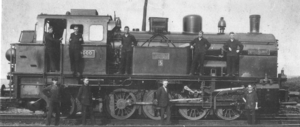WEBA 5
| WEBA 5 | |
|---|---|
|
Weba 5 District Administrator Dr. ground
|
|
| Numbering: |
WEBA 5 Rheinisch-Westfälische Kalkwerke 87 |
| Number: | 1 |
| Manufacturer: | Young |
| Year of construction (s): | 1927 |
| Retirement: | 1963 |
| Type : | D1 'h2t |
| Gauge : | 1435 mm ( standard gauge ) |
| Length over buffers: | 11,630 mm |
| Height: | 4,250 mm |
| Width: | 3,100 mm |
| Fixed wheelbase: | 2,800 mm |
| Total wheelbase: | 6,500 mm |
| Empty mass: | 58 t |
| Service mass: | 72 t |
| Friction mass: | 62 t |
| Wheel set mass : | 14.4 t |
| Top speed: | 45 km / h |
| Indexed performance : | 552 kW (750 hp) |
| Starting tractive effort: | 120 kN |
| Driving wheel diameter: | 1,200 mm |
| Rear wheel diameter: | 1,000 mm |
| Control type : | Heusinger |
| Cylinder diameter: | 530 mm |
| Piston stroke: | 600 mm |
| Boiler overpressure: | 13 bar |
| Grate area: | 2 m² |
| Superheater area : | 37.5 m² |
| Evaporation heating surface: | 138 m² |
| Water supply: | 8 m³ |
| Fuel supply: | 2.5 t |
| Brake: |
Compressed air brake type Knorr handbrake |
The tank locomotive WEBA 5 was built by the German locomotive factory Jung for the Westerwaldbahn . It entered service in 1927 and was the company's first superheated steam locomotive . It was with the Westerwaldbahn until 1955 and was then used by the Rheinisch-Westfälische Kalkwerke until 1963. It was scrapped in 1964.
history
The locomotive with the D1 'wheel arrangement was built in 1927 and delivered to the Westerwaldbahn. It was called District Administrator Dr. Boden named after Wilhelm Boden , the then district administrator of the Altenkirchen district and later first Prime Minister of Rhineland-Palatinate , who had promoted the expansion of the Westerwaldbahn. When it was put into operation, a brass plate with the name on it was attached to the smoke chamber. The sign was removed during the Nazi era . After dismantling, the locomotive was still used by Dr. Called soil .
The locomotive was very efficient. At the end of the Second World War , it was badly damaged by air fire and extensively repaired by Jung. In 1955 it received its last general inspection . With the use of the V 26.1–4 on the Westerwaldbahn, the locomotive became superfluous. Therefore it was sold to the Rheinisch-Westfälische Kalkwerke AG with valid deadlines in 1957 and bore the number 87 here . The locomotive performed shunting work here until 1963 and was retired and scrapped in 1964.
technology
The locomotive had a cladding of the smoke chamber and a free-standing water tank on the side. The rear axle was moved far under the driver's cab, which meant that the boiler could be made longer and more powerful. The inner frame consisted of two 10,030 mm long side panels with a thickness of 25 mm. The entire frame construction was designed as a water tank.
The riveted boiler had a diameter of 1,500 mm. It consisted of two sections, the center of the boiler was 2,700 mm above the top edge of the rails , the pipes were 4,000 mm long. He had a large tube superheater type Schmidt, plus an exhaust steam preheater type Werle , which was originally fed by two piston feed pumps driven by the axles .
The middle three axles of the chassis were firmly mounted in the frame, the first drive axle had a side play of +/- 22 mm, the running axle was designed as an Adam axle with a lateral radial play of +/- 50 mm. The third axis was the driving axis. The locomotive originally had a Latowski type of steam bell ; later it was given a compressed air bell. The pneumatic sand spreader sanded the first two axles from the front, the drive axle from the front and rear, and the fourth axle from the rear. At the time of construction, the locomotive was fitted with Pintsch gas lighting , and later electrical lighting. The alternator for this was arranged between the chimney and the bell.
literature
- Stefan Lauscher / Gerhard Moll: Young Locomotives, Volume 2: Types and Types . EK-Verlag, Freiburg 2014, ISBN 978-3-88255-798-5 , p. 164 .
- Willi Merzhäuser: The Westerwaldbahn . EK-Verlag, Freiburg 1986, ISBN 3-88255-578-5 , p. 75-76 .
